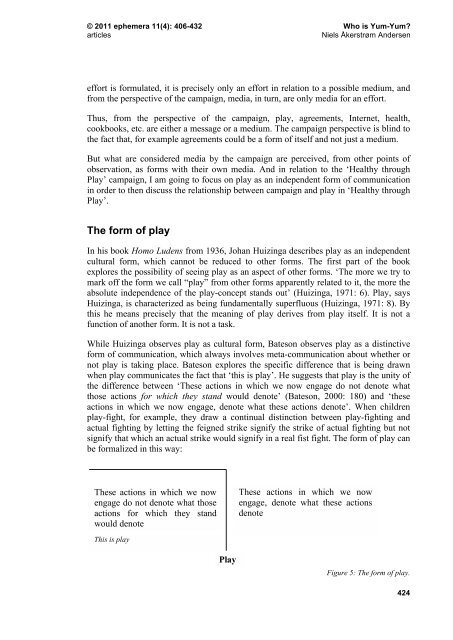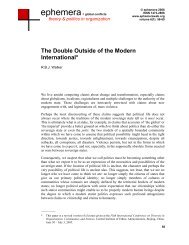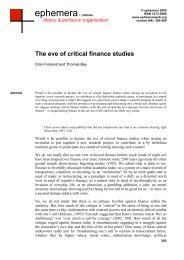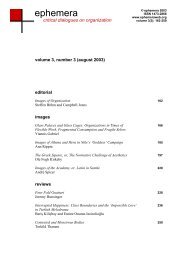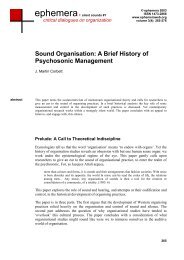Work, play and boredom - Ephemera
Work, play and boredom - Ephemera
Work, play and boredom - Ephemera
Create successful ePaper yourself
Turn your PDF publications into a flip-book with our unique Google optimized e-Paper software.
© 2011 ephemera 11(4): 406-432 Who is Yum-Yum?<br />
articles Niels Åkerstrøm Andersen<br />
effort is formulated, it is precisely only an effort in relation to a possible medium, <strong>and</strong><br />
from the perspective of the campaign, media, in turn, are only media for an effort.<br />
Thus, from the perspective of the campaign, <strong>play</strong>, agreements, Internet, health,<br />
cookbooks, etc. are either a message or a medium. The campaign perspective is blind to<br />
the fact that, for example agreements could be a form of itself <strong>and</strong> not just a medium.<br />
But what are considered media by the campaign are perceived, from other points of<br />
observation, as forms with their own media. And in relation to the ‘Healthy through<br />
Play’ campaign, I am going to focus on <strong>play</strong> as an independent form of communication<br />
in order to then discuss the relationship between campaign <strong>and</strong> <strong>play</strong> in ‘Healthy through<br />
Play’.<br />
The form of <strong>play</strong><br />
In his book Homo Ludens from 1936, Johan Huizinga describes <strong>play</strong> as an independent<br />
cultural form, which cannot be reduced to other forms. The first part of the book<br />
explores the possibility of seeing <strong>play</strong> as an aspect of other forms. ‘The more we try to<br />
mark off the form we call “<strong>play</strong>” from other forms apparently related to it, the more the<br />
absolute independence of the <strong>play</strong>-concept st<strong>and</strong>s out’ (Huizinga, 1971: 6). Play, says<br />
Huizinga, is characterized as being fundamentally superfluous (Huizinga, 1971: 8). By<br />
this he means precisely that the meaning of <strong>play</strong> derives from <strong>play</strong> itself. It is not a<br />
function of another form. It is not a task.<br />
While Huizinga observes <strong>play</strong> as cultural form, Bateson observes <strong>play</strong> as a distinctive<br />
form of communication, which always involves meta-communication about whether or<br />
not <strong>play</strong> is taking place. Bateson explores the specific difference that is being drawn<br />
when <strong>play</strong> communicates the fact that ‘this is <strong>play</strong>’. He suggests that <strong>play</strong> is the unity of<br />
the difference between ‘These actions in which we now engage do not denote what<br />
those actions for which they st<strong>and</strong> would denote’ (Bateson, 2000: 180) <strong>and</strong> ‘these<br />
actions in which we now engage, denote what these actions denote’. When children<br />
<strong>play</strong>-fight, for example, they draw a continual distinction between <strong>play</strong>-fighting <strong>and</strong><br />
actual fighting by letting the feigned strike signify the strike of actual fighting but not<br />
signify that which an actual strike would signify in a real fist fight. The form of <strong>play</strong> can<br />
be formalized in this way:<br />
These actions in which we now<br />
engage do not denote what those<br />
actions for which they st<strong>and</strong><br />
would denote<br />
This is <strong>play</strong><br />
Play<br />
These actions in which we now<br />
engage, denote what these actions<br />
denote<br />
Figure 5: The form of <strong>play</strong>.<br />
424


